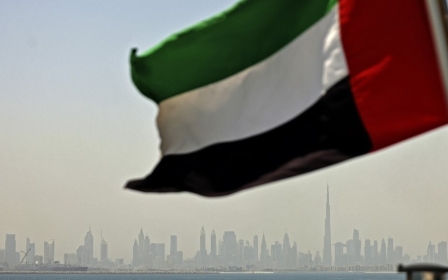Climate change and cloud seeding 'exacerbated' deadly flooding in Gulf countries

The death toll from severe flooding that hit the United Arab Emirates, Oman and other Gulf countries rose to almost 20 on Tuesday, with homes and businesses across the Gulf damaged by the heavy rains, and flights delayed or cancelled.
Analysts told Middle East Eye that climate change, infrastructure, the region's geography, and cloud seeding (in the UAE) may have exacerbated the flooding.
In Al Ain, an Emirati oasis city on the border with Oman, 254mm of rain was recorded in less than 24 hours, according to the National Meteorology Centre. That marked the highest level since records began in 1949.
An Emirati man in his 70s died after his vehicle was caught in the flooding in Ras al-Khaimah, one of the country's seven emirates, according to police.
The storms also hit Bahrain and parts of Qatar, days after flooding devastated neighbouring Oman.
Stay informed with MEE's newsletters
Sign up to get the latest alerts, insights and analysis, starting with Turkey Unpacked
Across Sunday and Monday, 18 people died in Oman as a result of heavy rain. Among the dead were at least nine schoolchildren, according to Oman News Agency.
Justin Dargin, a researcher at Oxford University specialising in climate and the Middle East, told MEE the "intensity and frequency" of destructive natural disasters in the region were linked to climate change.
"Climate change has indeed contributed to an increased risk of flooding across the Middle East. Jeddah, for example, has experienced a rise in unexpected heavy rainfall events in recent years," he said.
Mohammed Mahmoud, director of the climate and water programme at the Middle East Institute, said climate change "is an absolute driver of extreme weather".
He told MEE: "Though we mostly associate climate change with hotter temperatures, warming in coastal areas promotes severe rainfall and storms. Such is the case for the Gulf, where those surrounding warmer waters (close to the equator) help to generate storms that produce intense rainfall that cause these devastating flooding events."
Dargin said that infrastructural and geographic limitations also contributed.
"The region's arid climate, featuring sudden downpours combined with mountainous areas and desert valleys, creates conditions conducive to flash floods," he said, adding that limited drainage systems also worsened the impact.
Cloud seeding
To deal with water security issues, the UAE has since 2002 carried out cloud seeding: a weather modification procedure which involves implanting chemicals into the atmosphere to induce rainfall.
"Cloud seeding likely contributed to the severity," said Dargin. "However, the UAE's recent history of devastating flash floods, like those in 2020 and 2022, shows that recent bouts of heavy rainfall are the baseline of the increasing frequency of extreme rainfall events driven by climate change."
He said that cloud seeding could exacerbate such weather patterns and lead to even more severe flooding in future "if not undertaken judiciously".
The UAE government's National Center of Meteorology taskforce denied that cloud seeding had taken place in the run-up to this week's storms.
"One of the basic principles of cloud seeding is that you have to target clouds in its early stage before it rains, if you have a severe thunderstorm situation, then it is too late to conduct any seeding operation," Omar al-Yazeedi, deputy director of the task force, told CNBC.
Videos on social media showed collapsed roads and homes in the UAE, as well as vehicles completely submerged on Tuesday. One clip appeared to show planes taxiing across a flooded runway at Dubai International Airport.
The airport, the world's busiest for international traffic, saw significant disruption after passengers and crews struggled to arrive and depart on time. Several flights were cancelled or delayed on Tuesday.
"We are working hard to recover operations as quickly as possible in very challenging conditions," said the X account of the airport.
Though the heavy rains eased, delays continued into Wednesday, as the Emirates airline suspended check-ins for departing passengers until midnight.
An Asian Champions League match between the UAE's Al Ain and Saudi Arabia's Al-Hilal was postponed due to the weather.
Skies were clearer on Wednesday morning, though Emirati authorities ordered all government workers and schools to continue working remotely for a second day.
Mahmoud said that to address such flooding events, countries would need "improved water drainage and routing infrastructure and advance warning systems [for residents]".
"But even those have limitations if the weather event is too severe," he added.
Middle East Eye delivers independent and unrivalled coverage and analysis of the Middle East, North Africa and beyond. To learn more about republishing this content and the associated fees, please fill out this form. More about MEE can be found here.




